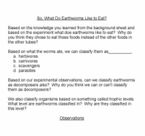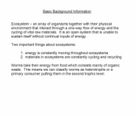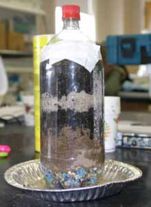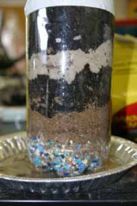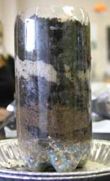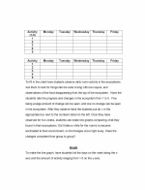Earthworm Ecosystems: What do Earthworms Like to Eat?
| Instant wiki maker | Making handouts | Editing tips |
Contents
- 1 What do Earthworms Like to Eat?
- 1.1 Student worthiness
- 1.2 Primary biological content area covered
- 1.3 Materials
- 1.4 Student Handout:
- 1.5 Description of activity
- 1.6 Lesson plan
- 1.7 Side Activity
- 1.8 Potential pitfalls and experiences
- 1.9 Math connections
- 1.10 Literature connections
- 1.11 Connections to educational standards
- 1.12 Next steps
- 1.13 Citations and links
Biology In Elementary Schools is a Saint Michael's College student project from a course that ran between 2007 and 2010 and fully described in this book chapter. The student-created resources have been preserved here for posterity. Link under 'toolbox' for printer-friendly versions of the exercises. Click on handouts to print full resolution versions. Please see Wikieducator's disclaimer, our safety statement, and the Creative Commons licensing in English and in legalese.
What do Earthworms Like to Eat?
Student worthiness
Tried and trusted
Primary biological content area covered
Worms; behavior; ecosystems; hypothesis testing; running experiments; data collection and interpretation
This experiment will introduce students to one form of ecosystem as well as demonstrate how earthworms and the foods they eat affect the environment in which they live.
Materials
Teacher Materials: Premade Soda Bottle Ecosystem (Directions Below)
- 2 Liter Soda Bottle (1 per group)
- Gravel
- Sand (any type except Perlite)
- Bedding Material
- Dark Potting Soil
- 1 pie plate or any type of water-catching plate (For each group)
- 1 piece of tin foil for each group
- 4 Earthworms for each group
- Electric Drill (optional)
- Utility Knife
Student Handout:
|
|
|
|
A helpful way to get the students involved and informed before the experiment is to give each group a handout like this (Handout 1), which gives students some background knowledge about ecosystems and earthworms. This activity also allows the students to use the knowledge they are acquiring in their science class and relate it to the experiment they will be conducting. Then, using the second worksheet (Handout 2) at the end of the experiment, students can use the knowledge they gained in class, from the experiment, and from previous knowledge to answer the questions on the sheet. Using simple worksheets like this can be a great addition to your project in order to emphasize the content of the lesson to your students.
Description of activity
During this activity, teachers will prepare three ecosystems for earth worms prior to performing the experiment above. In one ecosystem lettuce will be sprinkled on the top, in another a chocolate chip cookie will be sprinkled on top, and the third will remain as a control (only commercial worm food will be given to the worms). Once the ecosystems have been made and the earth worms have acclimated to their new homes, the experiment can begin. Students will form a hypothesis as to whether the worms will eat the lettuce, cheese, both, or none. They will also discuss what might happen to the ecosystems if the worms eat the foods given them. Students will then test their hypothesis by first using the directions listed below to prepare their own worm ecosystem. Once the ecosystems are prepared, students will place 4 worms into each of the 2 liter bottles and place their foods at the top. The groups will place lettuce on one half of the top of their bottles and cheese on the other half. Students will then observe which foods the worms preferred to eat, how the food changed the ecosystem, and how the worms changed their environment. Do their ecosystems look different than the controlled ecosystem for example? Did they mix the soil?. They will then discuss if their hypothesis was accepted or rejected. They can continue to discuss reasons why their hypotheses were accepted or rejected and then brainstorm a list of new foods that might be consumed by the worms, and why one food worked better than the other, if it did at all. A discussion on what this does for our soil and an explanation to students that this is what worms do underground is a great addition to the experiment, as it gives students a real world connection. If there is time or if the teacher would like to experiment further, the new lists of food can be compiled by the students and they can repeat the experiment again.
Lesson plan
|
|
Before the experiment begins the teacher will have had to prepare the control earthworm ecosystem (Figure 2) to show as an example to each group, the students will also use the instructions below to make their own ecosystems. To prepare the ecosystem use the following instructions:
Have teacher prepare steps 1-7 prior to beginning the experiment
- Take a clear 2 liter soda bottle.
- Rinse the bottle thoroughly with warm water only and remove the outside label.
- Mark a line all along the plastic indent where the top of the label usually begins.
- Cut along the line you have just marked.
- Using an electric drill (or other sharp tool) poke four to five holes in the bottle cap.
- Poke four to six holes in the bottom of the bottle for drainage purposes.
- Poke ten to twelve holes in the top half of the bottle for air circulation.
- Add clean, washed gravel into the bottle.
- Next add a layer of moist bedding material'*.
- Next, add a layer of dark potting soil'*.
- Add a layer of moist sand'*.
- Add a second layer of dark potting soil.
- Next, add a thin layer of lettuce or chocolate chip cookie (any food type can be used).
- Finally add your worms to the ecosystem (no more than five per bottle).
- Place the ecosystem on a foil pie plate or other plate so that the water from the soil does not drip everywhere.
- Cover the entire bottle with foil to keep the ecosystem dark and cool. Be sure that air can still flow into the bottle.
- Store the ecosystem at room temperature or colder. Avoid freezing temperatures.
Once students have created their ecosystems, the experiment can begin. The problem that should be presented to the students is "What do our earthworms like to eat?" Students will then form and write down a hypothesis regarding food types that earthworms like to eat. Students will observe the worms in their ecosystems in their classrooms at school. They will use their observations to answer questions like,"Which foods did our earthworms like?", "Which foods did our earthworms dislike?", and "Why?" Also, focus on the ecosystems by asking the students how their ecosystems changed. After answering these questions return to the students' hypotheses and discuss whether they were accepted or refuted. Discuss together why they were accepted or refuted. Discuss other possibilities for food choices based on your results, also talk with the students about their observations and changes in their ecosystems. For example, did they notice that the soil became mixed? If desired, the experiment can be repeated using new foods.
'* Younger students in particular may have a hard time making the materials moist without making a soupy mess. For that reason it is well worth the effort to moisten the materials in advance.
Side Activity
Before the experiment begins the teacher can take photos of the earthworm ecosystems created in the soda bottles (Figure 2). Earthworms tend to mix the layers within their environment. Having photos before, during, and after the experiment, combined with observation by the students, will allow students to assess the changes in the worm environment, creating a fun side project for the students. For our experiment, we started by taking a picture within the first hour our ecosystem was created. Then, we took a picture one week after the first photo (figure 3). In the photo, you can see the soil becoming mixed in the bedding.
|
|
Potential pitfalls and experiences
The need for most of the materials in the ecosystems to be moist can create a messy situation for the students when creating their ecosystems. A good way to avoid this is to make sure the soil, sand, and bedding are moist prior to having the students make their ecosystems. Also, we found that with the bottles filled as in the photographs, worms tended to escape. This can be prevented by filling the bottles to a lower level. To reduce mold growth on top, drill larger holes and consider other non-dairy food types such as leaf litter. After completing the experiment with six groups of six third graders, I found that the math worksheet that we handed out to each of the groups worked well in connection with the line graphs the kids were already doing in the classroom at school. If I could do the experiment again I would leave more time to explain the graph at the end of the experiment. I felt like I was rushed to explain to the kids what they needed to be doing. Overall, I was very pleased with the way the experiment turned out. The children had a great time playing with all of the worms and had a lot of insight into how worms and the environment they live in can relate back to humans and how we live each and every day. I am very pleased with the experiment.
Math connections
Once the children have recorded and discussed their findings in their groups, the students can decide which foods worked the best and which foods the earthworms did not like to eat. The class can create a bar graph together, comparing the findings in each. This will allow the students to see which food worked better in the experiment in a clear, visual way. The students can also make a table with categories from 1-5, 1 being the lowest amount of environmental activity, and five being a great deal of environmental activity. Each day they can write the number down, and after a couple of weeks students can create a line graph for the days and the amount of activity the saw within their ecosystems. Perhaps, the longer the worms were in their environments, the more changes they saw? If this is the case, the teacher can then compare to human environments and the changes that occur once we become comfortable and acclimated to our environment.
|
|
Literature connections
The Diary of a Worm by Doreen Cronin There's a Hair in My Dirt: A Worm's Story by Gary Larson
Connections to educational standards
S:37- Interdependence with ecosystems: Students demonstrate their understanding of recycling in an ecosystem.
S3-4:4 Students demonstrate their ability to conduct experiments by referring to and following a detailed plan for an investigation and clearly describing evidence and quantifying observations with appropriate units and recording data at various points during an investigation by reporting what actually happens, even when data conflicts with expectations.
Next steps
Now that the experiment is complete you can take it one step further and have the students research why the worms chose the foods they did. Have them research things such as how worms choose foods. Do they use sight, smell, or touch to determine what the food is? Do they even determine what it is at all? Have the students research the worm's digestive system as a means to discover if some foods can even be digested by worms at all. Students can also research how the different types of foods the worms eat affects their environment and more specifically their ecosystem. This experiment can branch out to many other little experiments or research projects that are beneficial to students learning about worms and their environment.
Like the third grade visitors who made ecosystems, you can have your class and others participate in an activity where each class compares their ecosystems to each others. Each classroom can maintain one ecosystem as a focus point and put one type of food in their ecosystem that is different from all the other ecosystems. The students in each class can monitor their own ecosystem using observation notes and a line graph (handout provided above). Once they have observed the rate at which their own ecosystem's food has disappeared, they can meet with the other classrooms and compare how fast it took for their specific food type to disappear. Students can discuss the reasons why they think this may have happened and talk about how their hypotheses were refuted or accepted.
Citations and links
Worm Watch Canada http://www.naturewatch.ca/english/wormwatch/ 2002.
Vermont State Grade Expectations can be found at the State of Vermont Department of Education website. http://education.vermont.gov/new/html/pgm_curriculum/science/gle.html

